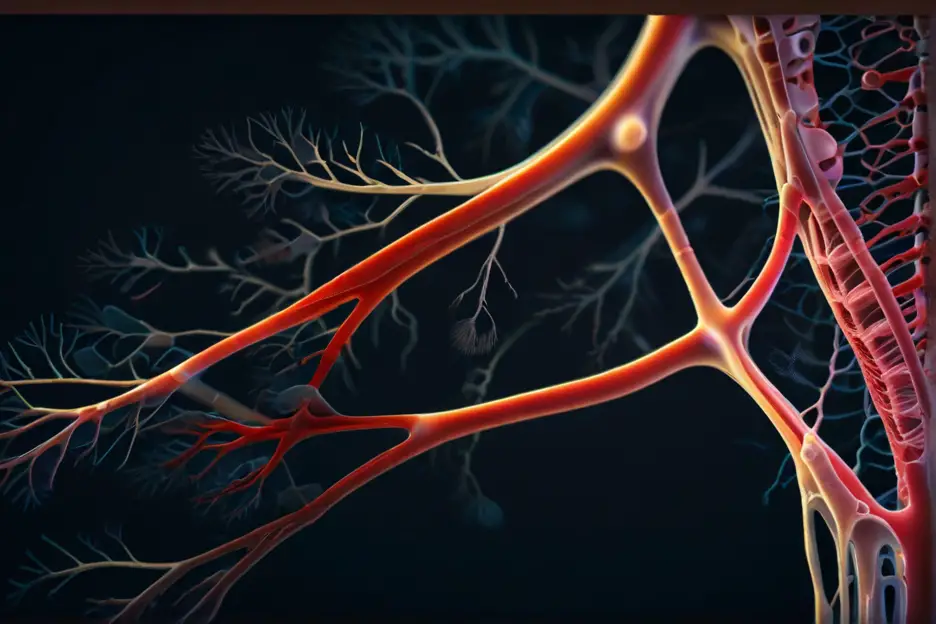
The nervous system is a complex and fascinating network of cells and structures that allows us to perceive, process, and respond to the world around us.
In this blog post, we’ll delve into the inner workings of the nervous system, exploring the key players, how messages travel, and the different parts of this intricate system.
The Key Players
Let’s delve into the key players of the nervous system and understand their roles in our body’s functioning:
Brain
Picture the brain as the mastermind behind everything.
It’s like the CEO of a company, making all the big decisions and keeping everything in order.
This remarkable organ processes information from our senses, helps us think, remember, and basically runs the show.
Think of it as a complex computer with different departments, each handling specific tasks.
For instance, there’s the frontal lobe, responsible for decision-making and problem-solving, while the occipital lobe takes care of visual processing.
- Read also: The Intriguing World of Brain Stem Reflexes
- Read also: 10 Mind-Blowing Types of Brain Imaging Techniques
Spinal Cord
Now, imagine the spinal cord as the superhighway connecting the brain to the rest of the body.
It’s like a long, sturdy bridge that carries messages back and forth.
These messages travel in the form of electrical signals, zooming along the spinal cord to reach their destinations.
Protected by the bony vertebrae of the spine, the spinal cord ensures smooth communication between the brain and various body parts.
Whether it’s lifting a finger or feeling a gentle touch, the spinal cord plays a crucial role in making it happen.
Nerves
Picture nerves as the messengers, delivering important updates and commands throughout the body.
They’re like the network of wires in a complicated machine, transmitting electrical signals far and wide.
These signals zip along the nerves, traveling at lightning speed to convey sensations, movements, and instructions.
Whether it’s feeling the warmth of sunlight on your skin or reacting quickly to a sudden sound, nerves ensure that communication between the brain, spinal cord, and the rest of the body remains swift and efficient.

How Messages Travel
Messages within the nervous system move like lightning, traveling as electrical impulses along specialized cells known as neurons.
These neurons are the real stars of the show, playing a vital role in transmitting information throughout our bodies.
Neurons
Neurons come in various shapes and sizes, but they all share the same fundamental function: transmitting messages.
Think of neurons as the messengers of the nervous system, shuttling important information to and from the brain and spinal cord.
Sensory neurons
Imagine sensory neurons as the scouts, constantly gathering information from our senses like sight, touch, smell, and more.
When you feel a gentle breeze or hear the chirping of birds, it’s thanks to these neurons.
They then swiftly relay this sensory data to the brain for processing and interpretation.
Motor neurons
Motor neurons, on the other hand, are like the commanders, issuing instructions from the brain to our muscles.
When you decide to take a step forward or raise your hand, it’s motor neurons that spring into action, sending signals to the appropriate muscles and prompting them to move.
Interneurons
Interneurons are the mediators, working behind the scenes within the brain and spinal cord to process and relay information.
They play a crucial role in integrating sensory input, coordinating motor responses, and facilitating complex cognitive functions.
Essentially, they’re the glue that holds the nervous system together, ensuring smooth communication between different parts of the body.

The Path of a Signal
Let’s walk through the journey of a signal in response to a common scenario: touching a hot stove.
Here’s how it unfolds:
Sensory neurons detect the heat
As your fingertips make contact with the hot surface of the stove, specialized sensory neurons immediately spring into action.
These neurons are finely tuned to detect changes in temperature and swiftly transmit this information to your brain.
Message relay to the brain
The sensory neurons waste no time in sending a distress signal to your brain.
This message travels along the nerves, zipping through the intricate pathways of your nervous system until it reaches its destination: the brain.
Here, the incoming signal is interpreted as a warning sign of potential danger.
Brain processes the sensation
Upon receiving the signal, your brain goes into overdrive, quickly analyzing the information it has received.
In this case, it recognizes the sensation as pain, signaling that immediate action is needed to prevent further harm.
Response initiated by motor neurons
With the danger identified, your brain swiftly formulates a response.
It sends out a rapid-fire message to the motor neurons, which serve as the messengers to your muscles.
These motor neurons receive the command to act and spring into action, sending signals to the muscles in your hand.
Muscles withdraw from the heat
In response to the command from the brain, the muscles in your hand contract involuntarily.
This reflex action causes your hand to instinctively withdraw from the source of heat, protecting it from further injury.

The Different Parts of the Nervous System
Let’s explore the different components of the nervous system and their functions in more detail:
Central Nervous System (CNS)
Think of the CNS as the headquarters of your body’s nervous system.
It comprises the brain and spinal cord, serving as the central command center for all conscious thought and activity.
From processing sensory information to orchestrating complex movements, the CNS plays a vital role in regulating our everyday actions and behaviors.
Peripheral Nervous System (PNS)
Picture the PNS as the vast network of highways branching out from the CNS, connecting it to every corner of your body.
Made up of nerves and ganglia, the PNS serves as the communication channel between the CNS and various organs, muscles, and tissues.
It’s responsible for relaying sensory information from the body to the brain and carrying out motor commands from the brain to the body.
Somatic Nervous System (SNS)
The SNS is like the conductor of voluntary actions, controlling movements that we consciously initiate.
Whether it’s raising your hand or taking a step forward, the SNS is in charge of coordinating these voluntary muscle movements, allowing us to interact with our environment and carry out daily activities.
Autonomic Nervous System (ANS)
Unlike the SNS, the ANS operates without our conscious control, managing involuntary actions that keep our bodies functioning smoothly.
This system regulates essential bodily functions such as heart rate, digestion, and respiratory rate, ensuring that vital processes continue uninterrupted without our direct input.
Sympathetic Nervous System
When faced with stressful situations or perceived threats, the sympathetic nervous system kicks into high gear, triggering the famous fight-or-flight response.
This physiological reaction prepares the body to either confront the danger head-on or flee from it, mobilizing resources to deal with the situation effectively.
Parasympathetic Nervous System
In contrast to the sympathetic nervous system’s response to stress, the parasympathetic nervous system promotes relaxation and conservation of energy.
Often referred to as the rest-and-digest response, this system helps calm the body down after a stressful event, allowing it to rest, recover, and replenish its resources.

- Read also: Rewiring Your Anxious Brain: Unraveling the Path to Inner Calm
- Read also: Secrets of the Backbrain: A Deep Dive into Posterior Brain Function
Conclusion
The nervous system is a complex and intricate network of cells and structures that allow us to interact with the world around us.
By understanding the key players, how messages travel, and the different parts of the nervous system, we can gain a deeper appreciation for the marvels of the human body.
FAQs
The central nervous system (CNS) consists of the brain and spinal cord, while the peripheral nervous system (PNS) is a network of nerves that connects the CNS to the rest of the body.
Sensory neurons detect information from the senses (sight, touch, smell, etc.) and send it to the brain for processing.
Interneurons process and relay information within the brain and spinal cord, acting as connectors between different regions of the nervous system.
The autonomic nervous system manages involuntary actions, such as heart rate and digestion, without conscious thought or control.
The sympathetic nervous system is responsible for the fight-or-flight response during stressful situations, while the parasympathetic nervous system promotes relaxation and is part of the rest-and-digest response.


